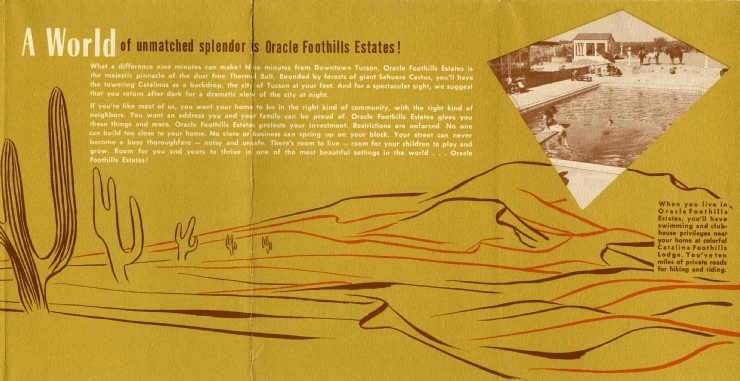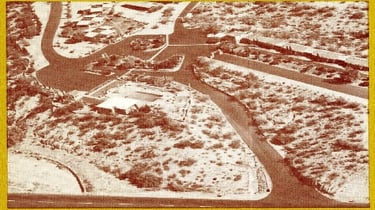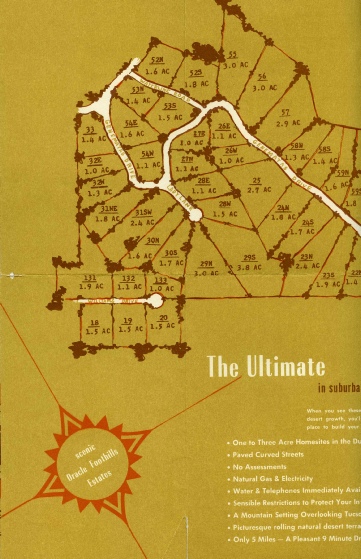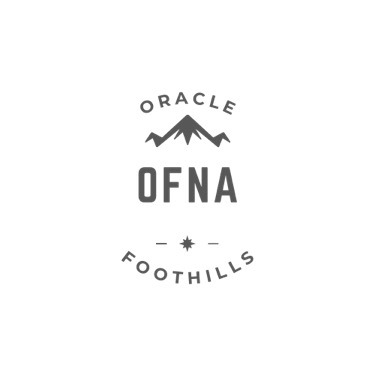Our History
In 1949, Oracle Foothills was a brand new community above the city lights, developed by Greek immigrant Nicholas W. Genematas and his sons.
We welcome contributions to the history page. If any of you have photos, stories, newspaper clippings or other items of historical interest, either about the neighborhood or your house, please consider sharing them here with your neighbors.
Contact Carole DeAngeli
The Original Sales Brochure
Longtime Oracle Foothills resident Leo Roop still has the original sales brochure from the time he purchased his house on Genematas Drive.








Our neighborhood was founded by Nicholas "Nick" William Genematas, who in 1902 came to America from Peloponnesus, Greece. He first lived in St. Louis and then moved to Detroit, where he opened a grocery. When the Balkan War flared in 1913, he returned home and fought in the Greek Army. When WWI broke out, he came back to America to join the US Army, which earned him American citizenship. In 1919 or 1920, with the war over, he opened Marathon Linen Service, Inc., which served factories, restaurants, and other businesses in Detroit, including Ford Motors. Oracle Foothills Estates was a division of Marathon.
In Detroit, he met and married Marie, a French-Canadian. They had a daughter, Patricia, and two sons, William Nicholas and George Nicholas. Genematas' father was Nicholas William Genematas. Traditionally, Greek fathers give their names to their sons by transposing or sharing their own first and middle names, so there are no juniors or seniors. Nick fought recurrent, serious bouts of emphysema or asthma, so his son Bill had to run the linen service much of the time. In December of 1940, son Bill asked a friend and Tucson native George Diamos about Arizona's climate. Michigan doctors had warned Genematas that he needed a drier climate, such as our Southwest. Diamos touted Tucson's salubrious air. So, Nick, Marie, and Patricia boarded a westbound train, but Nick nearly didn't arrive. He fell ill en route and spent 2 ½ weeks in an El Paso hospital. When he did reach Tucson, he recuperated at the Pioneer Hotel
When he recovered, the Genematas family moved out to Perkins Ranch on River Road, where El Corral Steakhouse is now. They liked it there. The main house, with the office, dining room, and social rooms, was close to the road, and the casitas (bungalows) sat back on the bluff. Genematas fell in love with Tucson and its climate, both because it helped his health and because it reminded him of Greece.
Looking for a place of his own, Genematas went up on Rudasill Road and bought a 5-acre homestead with a rock house. Then he bought another 5 acres. An estate was born. They were out in the country, far from downtown. At first, due to wartime shortages, the family had no phone. The one line in the area already had 20 parties on it, so Genematas had an arrangement with a friend to field his calls and then come get him. Finally, in 1942, the family got a phone...a 10-party line! And, they thought themselves lucky at that. Son Bill got drafted in WWII, so Nick had to periodically return to Detroit to manage the business.
In 1943 or '44 while Genematas was down in town, a huge flood kept him from returning home across Pima Wash. Where Pima Wash crosses Rudasill used to be a sandy dry-weather-only crossing, and even today it occasionally runs. Marie worried about him, especially considering his health, so he vowed to never be kept away from home again.
From their home at the northwest corner of our neighborhood, Genematas headed cross-country and drove the highest ridge east of Pima Wash down to Oracle Highway. He went on into town and asked a realtor, "Who owns both sides of that track?" Then he negotiated to buy those large parcels along the ridge from three private persons. That track became Genematas Drive, and the land formed the nucleus of Oracle Foothill Estates. And he had his flood-proof access.
At home he built many rock-lined trails and, after drilling two wells, planted a number of fruit trees. Today, the home is hidden by the giant eucalyptus and Italian cypress trees he planted. He built a swimming pool, about 25 feet by 15 feet, which also served as a reservoir for water to irrigate his trees. The pool had no filter but, since the water was drained so often, it stayed clear enough for swimming. The pool was drained twice in winter, and three times in summer. A barbecue fireplace was also built near the pool.
Since Genematas had ensured his road home, he decided to recruit some neighbors to share the area and had a surveyor by the name of Stevens subdivide parcels. At first, the land was divided into 3 to 5-acre lots, but he realized those were "too large" and re-subdivided most of them into smaller lots. Many of the 5-acre lots were cut into thirds, and the 3-acre lots roughly into halves. Throughout development, he insisted that the desert land be kept intact, unfenced, and unbladed so neighbors could enjoy the desert as he did.
About the same time, Genematas started a 300-acre subdivision west of Oracle. Also, he built the Foothills Lodge in 1945. It featured Michigan ranch-style furniture and Genematas even entertained the governor of Michigan there.
When Genematas began to slow down in the early 1960s, he chose George Diamos to represent his interests. Diamos made a deal with home-builder Farrel Copeland, who had Copeland Construction Company. The Oracle Foothills Estates company released five or six lots per year to Copeland for $3,000 each. Copeland re-subdivided Oracle Foothills Estates # 2 into # 7 and # 8. The Copeland Company built homes for $8-9 a square foot and then sold them for $12–15 per square foot, including the land. Copeland was so successful that he used up all the lots in half the time they had predicted.
The home estate boasted lemon and tangerine trees, as well as date palms and a vegetable garden with garlic. He had a flagpole and flew the US flag daily. Also, he flew state flags of Illinois and of Michigan when the governors of those states came to visit him on vacations. He had a very sharp, inquisitive mind. Among other interests, he studied comparative religions.
Nick and Marie added a large sunroom and a large bedroom. He raised chickens and peacocks, and fed and watered the wildlife. He did keep a shotgun above the fireplace in the kitchen. On his first visit, Uncle George Genematas looked out the window and jumped for that shotgun. After some commotion and a quick discussion--"Those are my pets!"-- Nick persuaded his brother not to shoot his tame quail.
He had a well at the house and another between the main home and the guest house. He piped water down into three steel tanks placed in Pima Wash for the animals. He had bought the tanks (B-17 and B-29 wing tanks) from Pappadias junkyard on Stone. Also, he put out salt blocks. Diamos himself last saw deer in the canyons before 1955; javelina and wildcat up to 1985. One wildcat had a bed near Genematas' house. In 1971, as Diamos drove through Pima Wash, a mountain lion sprang across the road in front of his car.
Genematas put in two more wells: one near Yvon and another in Pima Wash, next to what became the golf course. With two on the homesite, these gave the neighborhood four wells. He formed the Oracle Foothills Water Company, which he later sold to Copeland, who in turn sold it to the city of Tucson.
Genematas developed the Cliff Manor Hotel, the first fire-proof hotel in Pima County. In 1962, he built Cliff Valley Golf Club, an executive, par-3 course. Nick had been a waiter in his youth with Skouras Brothers restaurant in St. Louis, Missouri. In 1963, he developed Cliff Manor Restaurant for Johnny Gekas. It was a beautiful place, with three tiers and an expansive view. One day, a helicopter landed in a vacant field while its occupants went to Cliff Manor Restaurant for lunch. Genematas saw a business opportunity: he called the newspaper and waited at their table in a chef outfit. He got his picture in the paper, too!
Gekas closed the restaurant during August every year so that his employees could have a vacation, but although he was receiving August's rent, Genematas did not get his percentage of any August gross, so he evicted Gekas. Johnny Paulos took over and the restaurant did quite well for a while, but while he ran it, his other restaurant--Paulos on Speedway, declined, so reluctantly he left Cliff Manor. From then on the restaurant waned, despite everyone's efforts, including proprietors Bill and Georgie Muniz. One New Year's Eve it was destroyed by an electrical fire. At one time Gekas, who was also renowned for his Palomino Restaurant, lived on the northeast corner of Georgia and Yvon.
Genematas supported President Richard Harvill on the creation of the UA medical school. When Harvill asked how many donation-bricks he was going to give, Genematas said, "Do you know Hippocrates, the Greek father of physicians? I'll give him." So Genematas made three trips to Greece to select a sculptor and marble for the Hippocrates statue at UA Medical School. He also gave one to Wayne State University in Michigan. The statue was popular and the Greek sculptor made several others, including one for the University of Illinois Medical School. When the statue arrived in Tucson, Genematas got to see it in the crate but, sadly, he died before it could be erected and dedicated.
Mr. Nick Genematas died on October 30, 1967. It's ironic that a Greek from Michigan had such foresight nearly 60 years ago to preserve a Sonoran Desert neighborhood for us so that today we still can enjoy the plants, wildlife, and vistas as he saw and loved them.
More information on the Genematas family can be found in Vicki Thompson's Across the Dry Rillito. (Tucson: Territorial Publishers, 1979) and Across the Dry Rillito, II (Tucson: Territorial Publishers, 1986).
History of Oracle Foothills Estates
By Bill Broyles
Some of you may have purchased your home or lot from George Diamos, a close friend and business partner of Nick Genematas, who founded our Oracle Foothills Estates neighborhood.
Diamos was an interesting character in his own right. In the words of one real estate competitor, George was an "old-school gentleman," whose word was as good as a contract. He loved people and his hometown of Tucson.
Like Nick, George's name and heritage were Greek. His father, who came with four brothers to Tucson in 1900 from Greece, shortened the family name of Diamantatsikos to Diamos. His mother's relatives came to Sonora from Basque country in 1830 and settled on the Rio Yaqui; others came later, in 1865, and some moved to Tucson. George was born on October 20, 1920.
Diamos' father and uncles were capable businessmen. They did miss one deal, however, which George later lamented. In 1925 Diamos' father had been offered as much foothills property as he could buy for $1 per acre, but his dad and uncles dealt in commercial real estate and property management (such as movie theaters), so he turned the offer down. Who could have foreseen Tucson's explosive growth? George spent much of his own career working residential real estate in those same foothills.
His father helped many Greeks pass through southern Arizona. He made small loans (most $25-100) to them and kept notes in a big ledger book. Years later George Diamos cleared the book, saying most of the recipients were probably long dead. But some did repay later, sending George an envelope with $20 bills or a deed to 40 acres in Missouri or a homestead in California. Throughout his life, George met people who related the charity of his father who had never mentioned it to his son.
George Diamos grew up in Tucson as a self-described Greek Mexican. He grew up in the barrio and was Roman Catholic, not Greek Orthodox, because of his mother's background. He claimed to have been a terror in his youth. He played rough-house baseball and had kite fights using homemade kites with razor blades taped to the edges to shred other kites in aerial duels.
He tried public school but was too mischievous: he rode his bike in the halls, broke a teacher's window with rocks, and played so much hookey that in later years probation officer Meyer frequently kidded him about it at Rotary meetings. On his days off school, he loved to hike into the Tucson and Catalina mountains, which he knew well. Even a stint with the sisters at Sts. Peter and Paul couldn't change him, so his parents sent him to a southern California boarding school at age 11 and later to New Mexico Military Institute in Roswell. The homesickness eventually cured him.
When he returned to Tucson for college, he met and married Irene, raised a family, and embarked on a distinguished career in business. For a number of years, he ran his father's motion picture theaters in southern Arizona. Later he became a decorated veteran of WWII and then a Realtor. George Diamos died February 20, 1995.
George Diamos
History of Oracle Foothills Streets
To know the street names of Oracle Foothills Estates is to know the Genematas family, who founded our neighborhood. According to George Diamos and his grandson Nick Genematas, our streets were coined principally by the senior Nick Genematas.
Lady Lane: This unpaved street was named for Genematas' favorite horse! Nick Genematas adds that it was a Palomino.
Agave Drive: Genematas loved agave plants [Agave americana], and he planted a number of them at his home on what is now Williams Drive.
Canyon View Drive: This is an aptly descriptive name for a road that gives a view down the arroyo canyons leading to the Rillito.
Cherie/Cherrie Lane: This name appears on early plat maps off Yvon, but it was never built. It is named for a horse: the foal of Lady.
Genematas Drive: Named for the Genematas family or for Nick Genematas himself. There is neither a "Nick St." nor a "St. Nick" listed here.
Georgia Drive: George Diamos believed that this street may have been named for Georgette someone, or perhaps Uncle George Genematas had a daughter by this name, but it was not named for his friend Georgia Muniz. Nick Genematas reports that it should be "George Drive," but his grandfather didn't want to name a street for himself, so he added a feminine ending.
Kerrigan Drive: It appears on some early maps but never was put in. Marie Genematas and Mrs. Kerrigan were first cousins. J.C. "Jack" Kerrigan worked for Genematas, and he died on the job. A 1947 stone marker at the Lodge lists him as its builder, along with "N.W. Genematas/ Designer/ F. Martinez/ J. Misquita/ Rock Masons."
Maria Drive: Named for Marie Genematas, Nick's wife. She died in April of 1974.
Maria Hill Drive: This extension of Maria Drive down the ridge was redone by Copeland when he re-drew subdivision boundaries, making Oracle Foothills #2 into #7 and #8. Most folks today just call it Maria Drive.
Nina Drive: Nina was named for Bill's wife; her father was from Sparta, Greece. She pronounced it "Nine'-uh."
Pump Road: A primitive utility trail between Yvon and River Road. Named for a well pump.
Waterline Road: This was the utility easement for the 2-inch water line from Genematas' well. It is listed on maps as an easement, and Genematas always considered it an easement because he once wanted to make it a street but was denied the zoning. Later, residents used it as a shortcut and nowadays it is paved.
Williams Street: This private street off of Rudasill was named for his son Bill. The Genematas' house was on this street.
Yvon Drive: Yvon was a Canadian cousin of Marie Genematas, who was of French-Canadian descent.
The following article appeared in The Arizona Territorial in March, 1979:
Nicholas W. Genematas, one of the early developers of Tucson’s northwest side, carried his Greek heritage proudly. “But he was even more proud, if possible, of being an American,” says his son George Genematas.
Although the American dream proved elusive for many immigrants, for Nick Genematas it came true. He arrived in the United States in 1904 at the age of 14. He then joined the legions of young immigrants who eked out a living as waiters and busboys.
Leaving American restaurants behind, the young Genematas dashed off to Greece in 1912 to fight with the Greek Army. He returned a year later to return to the restaurant business, this time opening one of his own.
With the advent of World War I, Nick Genematas sold his business and enlisted, encouraging his buddies to do the same. The Army sent his friends overseas, but they chose to send Nick to the University of Michigan instead, where he obtained an education and met his wife, Marie.
The rags to riches story continued as Mr. Genematas opened a linen supply business in Detroit. Although blessed with financial success, Mr. Genematas faced health problems. He had bronchial asthma. In 1940, he and Marie came to Tucson after his doctor gave him the proverbial “six months to live.”
Tucson worked the miracle cure for Mr. Genematas and he became one of the countless patients who outlived the doctor who prophesied his demise.
During his recuperation period, Mr. Genematas bought living quarters in the Catalina foothills. Rudasill Road, named after homesteader W. A. Rudasill, linked the Genematas family and other foothills residents with Oracle Road. Unfortunately, every heavy rain left many people marooned when Rudasill became impassable at the Pima Wash.
Nick Genematas conceived of a road which would follow the terrain from east of the wash south to Oracle Road. In order to build the road, he had to buy the land, which belonged to the Huntley family, homesteaders since 1928.
Mr. Genematas bought the land and built the road. His son George says that as far as he knows, Genematas Drive has never washed out.
The Genematas family began to develop the acreage into what is now the Catalina Foothills Lodge. George Genematas planted trees he purchased from another pioneer of the northwest side, Maurice Reid. While George planted, his father hired the whole University of Arizona football team to dig a swimming pool.
The swimming pool had a dual function. Besides providing a place to cool off, it also formed a reservoir of water for irrigation. A gravity feed system put water into the pool, and gravity drained it out for watering plants and trees. “The only thing I ever saw like it was in Rome,” says George Genematas. “I think Pope Leo III was the creator of that one.”
In addition to the lodge, Nick Genematas developed Oracle Foothills Estates, which eventually encompassed 2000 acres of residential lots. Many of the people who bought lots did so after staying as guests at the lodge and falling in love with the foothills. “This country sold itself,” remarks George Genematas.
Oracle Foothills Estates had the first natural gas to be brought in north of River Road. A pipe slung under the old wooden bridge at Oracle Road provided gas for the lots. During this time of development, a man named Dick Kroecker arrived in town with his bulldozer. “My father became fascinated with that bulldozer,” remembers his son George.
Nick Genematas put Mr. Kroecker to work. After the dust cleared, the Genematas family had built the Cliff House Restaurant, since destroyed by fire, and the Cliff Manor Inn. Northern Hills Estates on the west side of Oracle Road was developed later by the Genematas family.
It was George Genematas who purchased the land north of Rudasill Road for the purpose of building Casa Blanca Shopping Plaza. Casa Blanca incorporates several unusual features, including the dome from the old El Conquistador Hotel. George Genematas bought the dome during the demolition of the hotel, and had it placed above Misener’s Pharmacy in the plaza.
Casa Blanca’s “south of the border” flavor is enhanced by a generous use of ceramic tile. In addition, the Genematas family commissioned Francisco Lopez to create a replica of a fountain they admired in Tlaquepaque, Jalisco, in Mexico. A stone called “volcanic tuff” was used for the fountain, which rests in the open patio of the plaza and attracts its share of pennies.
Nick Genematas always dreamed of a shopping plaza, but he didn’t live to see its completion. On October 31, 1967, about three months after the ground-breaking ceremonies for Casa Blanca, he died.
In the last few months of his life he focused again on Greece. He wanted to mount a campaign to force England to return the Elgin marbles to their Greek home. George Genematas remembers his father’s grief when he saw the statues, during a visit to the British Museum, lying helter-skelter on the floor.
Nick Genematas didn’t succeed with the Elgin marbles. But his love of art prompted him, in the last year of his life, to have a statue of Hippocrates sculpted in Greece and sent to the U. of A. Medical School. Created from the same marble as the temples of the Acropolis, it stands as a measure of the affection Nicholas Genematas had for his adopted country of America
Dream of Immigrant Genematas Realized
By Vicki Thompson





